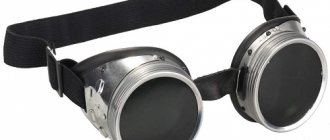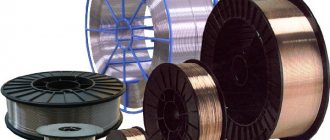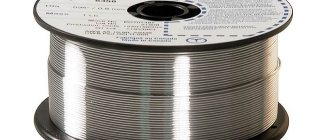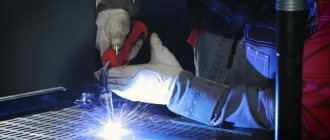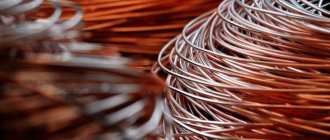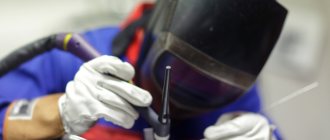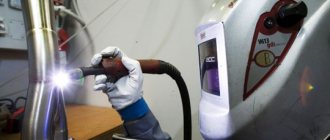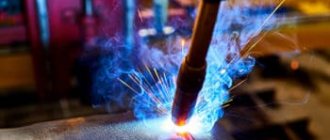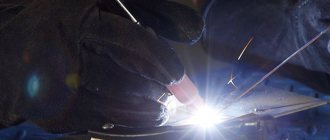How the base material elements combine with the filler metal elements plays a role in the final chemical composition and mechanical properties of the aluminum weld, including strength. From left to right, the diagram shows the least desirable dilution ratio at which problems may occur and the best dilution ratio for a more reliable weld.
Characteristics of aluminum alloys
The main difference between different series is the alloying element or elements, which, in turn, affect many of the characteristics of the series.
1xxx. This series is not heat treated and has tensile strengths ranging from 10,000 pounds per square inch (PSI) to 27,000 PSI. They are weldable, but due to their narrow melting range, special welding procedures are required to obtain acceptable welds. Their excellent corrosion resistance makes them suitable for use in specialized chemical tanks and piping; their excellent electrical conductivity makes them suitable for busbar applications. They have relatively low mechanical properties and are rarely used for general structural applications. These base alloys are often welded with suitable filler material or with 4xxx filler alloys, depending on the application and performance requirements.
2xxx. This series is heat treatable; tensile strength ranges from 27,000 to 62,000 psi. They contain copper content from 0.7 to 6.8 percent. These are high-strength, high-performance alloys often used in the aerospace and aircraft industries. They have excellent strength over a wide temperature range.
Some are considered non-weldable by arc welding processes due to their susceptibility to hot cracking and stress corrosion cracking; others are successfully arc welded using proper welding procedures. These base materials can often be welded using high-strength 2xxx series filler alloys to match their specifications, but in some cases they can be welded with 4xxx series filler materials containing silicon or a combination of silicon and copper, depending on the application and service requirements.
3xxx. These are non-heat-treatable alloys with tensile strengths ranging from 16,000 to 41,000 psi. The main alloying element is manganese, the content of which ranges from 0.05 to 1.8 percent. They have medium strength, good corrosion resistance, good formability and are suitable for use at elevated temperatures. One of their earliest uses was in pots and pans, and today they are a major component of heat exchangers in vehicles and power plants. Their moderate strength usually makes them unsuitable for use in construction. These base alloys are welded with 1xxx, 4xxx and 5xxx series filler alloys, depending on their specific chemistry and specific application and service requirements.
4xxx. This series includes both heat-treatable and non-heat-treatable alloys. Tensile strength ranges from 25,000 to 55,000 psi. They contain silicon in amounts ranging from 0.6 to 21.5 percent. Silicon lowers the melting point and improves melt flow. These characteristics are desirable for filler materials used for fusion welding and brazing; hence, this series of alloys is predominantly used as filler material. Silicon itself makes aluminum non-heat-treatable; however, the addition of magnesium or copper results in heat treatment of the alloy. Typically, these heat treatable filler alloys are used only when the component being welded must be heat treated after welding.
Filler material 4943 can provide a weld with approximately 25% increased tensile and shear strength in its original condition.
5xxx. This series, without heat treatment, has a tensile strength of 18,000 to 51,000 psi. They contain magnesium additives from 0.2 to 6.2 percent. They have the highest strength among non-heat-treatable alloys. Moreover, these alloys are easily weldable and are therefore used in various fields such as shipbuilding, transportation, pressure vessels, bridges and buildings. Base alloys with less than about 2.5 percent magnesium content are often welded successfully with 5xxx or 4xxx series filler alloys. Base alloy 5052 is generally considered the highest magnesium base alloy that can be welded with a 4xxx series filler alloy. Due to problems associated with eutectic melting and resulting poor mechanical properties after welding, materials in this series at the upper end of the magnesium scale should not be welded with 4xxx series filler materials; For these metals, 5xxx filler alloys are suitable, which usually match the composition of the base alloy.
6xxx. These heat-treatable metals have tensile strengths ranging from 18,000 to 58,000 psi. They contain small amounts of magnesium and silicon - about 1.0 percent. They are widely used in the welding industry, primarily in the form of profiles, and are incorporated into many structural components. Heat treatment of the solution increases their strength. These alloys are susceptible to solidification cracking and for this reason cannot be autogenously arc welded (without filler material). The filler metal dilutes the base material, thereby preventing hot cracking. They are welded with filler materials 4xxx and 5xxx, depending on the application and operating requirements.
7xxx. These heat-treatable alloys have tensile strengths ranging from 32,000 to 88,000 psi. The main alloying element is zinc in an amount from 0.8 to 12.0%. They are composed of some of the strongest aluminum alloys and are often used in high-performance applications such as aircraft, aerospace and sports equipment. Like the 2xxx alloys, this series includes some alloys that are considered unsuitable for arc welding, while others are often welded successfully. Commonly welded alloys in this series, such as 7005, are welded primarily with 5xxx series filler alloys.
Did you know that aluminum makes up 8 percent of the earth's crust? This material part is not only the very soil on which we stand, but also constitutes many of the things that surround us in our daily lives.
Among its many advantages, aluminum has formability, strength, corrosion resistance, light weight, strength, elasticity and energy absorption properties. For example, in semi-trailer manufacturing—an application where light weight is important—making various parts from aluminum rather than mild steel can reduce weight significantly, say by 1,000 pounds. for side wall 187 lbs. for tailgate, 60 lbs. for the cab roof and 30 lbs. on the wheel.
However, this material is not without its problems when it comes to welding. Because of aluminum's low melting point and high thermal conductivity, special care must be taken to prevent burn-through on thin gauges and to ensure adequate melting or penetration on thicker gauges.
When an application requires aluminum, the 6XXX series base material is typically selected due to its versatility for many applications. One particular alloy, 6061-T6, is often used in applications such as shipbuilding, automotive, and trailer construction.
Argon welding technology
Welding with argon, which falls under the definition of welding in a shielding gas environment, requires strict adherence to the instructions, which stipulate the sequence of actions performed by a specialist. Both the quality of the formed connection and the consumption of materials, which are not cheap, depend on how correctly all these actions are performed. If you have never performed such welding work, then you need to not only study step-by-step instructions, but also carefully watch video lessons that detail the entire technological process.
To weld aluminum and alloys based on this metal in an argon environment, you need not only the welding machine itself, but also additional equipment that provides storage and supply of consumables. Naturally, the technical condition of such equipment and the quality of all materials used directly affect the reliability of the connection being formed.
To perform argon welding of parts made of aluminum and alloys based on this metal, you will need the following equipment:
- a source of electric current to which the welding machine and all other equipment will be connected;
- a cylinder in which the protective gas argon is stored;
- a mechanism responsible for feeding filler wire into the welding zone.
When welding with argon at large industrial enterprises, shielding gas is supplied to the welding machine through a centralized network. The welding wire used in semi-automatic machines is pre-wound on special reels installed on such a machine. The working surfaces of workbenches on which welding operations are performed, according to the instructions, must be made of stainless steel.
Common obstacles with 6XXX base materials
The post-weld mechanical properties of the 6XXX series base material make it more sensitive to various welding parameters such as heat input and joint design compared to the 5XXX series materials.
For example, 6XXX series base materials have 30 percent greater thermal conductivity than 5XXX series base metals, making it difficult to produce consistent quality welds. The higher thermal conductivity of 6XXX alloys requires higher heat input to achieve the same penetration, which in turn can make the material more prone to deformation.
The use of heat treatment on 6XXX series base metals is one way to overcome some of the problems associated with the material. When welding 6XXX base materials, the microstructure of the heat-affected zone (HAZ) deteriorates and mechanical properties can be reduced by 30–50 percent. If the material was in T6 condition before welding, it can be solution heat treated and aged after welding, which will restore it to T6 condition.
It is also important to remove the oxide layer before welding any type of aluminum, including the 6XXX series. Use a stainless steel brush designed exclusively for this purpose. Otherwise, the heat input required to penetrate the oxide layer during welding may burn through the base material.
TIG welding of stainless steel
Manual argon welding begins, like all welding processes, with the preparation of workpieces. It is necessary to clean the joined ends to a metallic shine so that there is no dirt or deposits of other materials (for example, paint) left, and it is also necessary to degrease the adjacent surfaces. If stainless steel workpieces with a thickness of more than 4 mm are welded, then it is necessary to form the edges. Thin-walled parts are welded without edges.
By the way, when welding thin stainless steel, you need to install a copper plate under it, with the help of which heat will be removed. But this piece of copper will also perform other functions: it will hold the metal molten from the filler wire on the reverse side, and it will rigidly fix the two workpieces being connected. If both parts fit exactly together and are well fixed, then welding can be carried out without a filler rod. This applies mainly to workpieces with a maximum thickness of up to 1 mm. In this case, it is recommended to carry out welding with a current of 35-37 amperes, fill the crater for 3 seconds, and supply gas after the end of the welding process for 4 seconds.
Selecting the Suitable Filler Metal
When selecting a filler metal for 6XXX series aluminum, it is important to understand how the finished weld will be used. The desired outcome influences the choice. Will it be exposed to high temperatures for a long time? Are strength, ductility and toughness the key requirements? Determine which properties are most important to the finished weld and select the filler metal according to those priorities.
There is a trade-off when selecting filler metals: Some filler metals impart special properties to the final weld, such as high strength, crack resistance, or anodizability. The 4XXX series filler metal, for example, eliminates the possibility of color matching after anodizing the material, but allows for heat treatment of the weld. In contrast, the 5XXX series filler metal allows color matching after anodizing, but does not allow post-weld heat treatment (except for 5554).
Filler materials of the 4XXX and 5XXX series are most often used for welding aluminum of the 6XXX series. Consult the aluminum filler metal selection chart or selection guide to determine how filler metal selection may affect the following:
- Plastic
- Corrosion resistance
- Service at elevated temperatures
- Color matching after anodizing
- Post-weld heat treatment
- Durability
Black steels
These include not only carbon steels, but also low-alloy steels. They are welded using MMA, but a truly high-quality, durable welded joint can only be achieved with TIG. It is believed that low-carbon steels are the easiest to weld. However, processes occurring in the heat-affected area can lead to strengthening of excessively heated zones during conventional welding, and problems with embrittlement may appear during multilayer welding. In boiling and semi-quenched low-carbon steel, a drop in impact toughness is observed in the heat-affected zone. As is known, black steels containing carbon:
- up to 0.25% are considered well weldable (Article 3, Article 10). But if problems arise, such as those described above, a slight preheating of 150-200 degrees in the SNOL electric furnace is recommended.
- from 0.25 - 0.45% are considered difficult to weld or partially weldable. They need to be heated before welding manipulations with a tungsten electrode and must be heat treated after. If it is possible to carry out complete heat treatment, such as annealing or hardening + aging, this is the best option. But if the product is already ready, and no deformations are allowed in it, you will have to limit yourself to low-temperature tempering (or, as this process is also called, rest).
- from 0.45% carbon and above, steel is not used for welded structures, especially if it is even slightly alloyed. But this is for structures. If the product will not bear any loads, you can try to weld Art. 55, only without sudden temperature changes, using all the “metallurgical” tricks.
Read also: What kind of machine is needed for 6 kilowatts
And finally, we got to the welding rod. All of the above cases are welded with rod Sv.-08G2S GOST 2246-70 or its minor modifications. The deoxidizers silicon and manganese in its composition have a positive effect on the mechanical properties of the seam, inhibit the development of seam porosity, the appearance of shells, reduce spattering, etc. The rod is used for welding products or structures for critical purposes, such as vessels, high-pressure pipelines, loaded components and parts. Imported analogue of Sv.-08G2S: copper-plated welding rod ER 70S-6. Micron coating of copper is, of course, a big plus, since copper protects the steel rod from pitting corrosion and oxidation - these processes actively take place in warehouse storage conditions. ER 70S-6 rod does not need to be sanded before welding for fear that dirt on its surface will show up as defects in the weld.
Mechanical properties of metal in a weld when using ER 70S-6:
- Yield strength 525 MPa;
- Tensile strength 595 MPa;
- Elongation 26%;
- КV – 30°С 70 J.
4ХХХ series filler metals
When selecting a 4XXX series filler metal for use with 6XXX aluminum, the most popular options are 4043 and 4943.
The 4043 filler metal has several advantages, such as excellent resistance to cracking and corrosion, its ability to withstand post-weld heat treatment, its high temperature performance from 150 to 350 degrees Fahrenheit, and ductility. However, 4043 does not match the color of 5XXX filler metals when the part is anodized after welding, and its strength is lower than that of 5XXX filler metals.
The 4943 filler metal has many of the same characteristics as 4043, but is better heat treatable. Adding magnesium to the 4943 filler metal also provides higher repeatable strength without relying on dilution of the base material to create a strong weld.
The dilution process, in which elements of the base material are combined with elements of the filler metal, affects the final chemical composition and mechanical properties of the aluminum weld, including strength. While you can evaluate dilution and the resulting weld strength, numerous operator variables such as torch angle, travel speed, and amperage affect the penetration depth, which in turn affects dilution. As a result, you may not always get the approximate dilution according to your calculations. The use of 4943 filler metal solves the strength issue.
With 4943 filler metal, you can produce a weld with approximately 25% higher as-welded tensile and shear strength. This filler metal uses the same voltage and wire feed speed as 4043. It has high fluidity, low shrinkage and less weld fume than 4043. It can also be used to weld 1XXX, 3XXX and 5XXX base materials at less 3 percent magnesium (e.g. 5052), as well as 6XXX base metals.
Overall, 4XXX Series filler metals cause less weld discoloration and snagging compared to 5XXX Series filler metals, which can help reduce the time and money you spend on post-weld cleanup.
5XXX series filler materials. There are many options for 5XXX filler metal that can be used to weld 6XXX base aluminum. Two common options are 5356 and 5556.
When welding the 6XXX series, 5356 filler metal provides good crack resistance and strength, excellent ductility, acceptable corrosion resistance, excellent color matching ability after anodizing, and excellent toughness. Please note that these filler metals are not suitable for post-weld heat treatment or at high temperatures (150-350 degrees).
5556 filler materials have the same crack resistance, ductility and corrosion resistance as 5356, but they also offer even higher strength. Like 5356 alloys, 5556 filler metals do not withstand high temperature applications or post-weld heat treatment, but they are color-matched after anodizing.
Another 5XXX series filler metal, 5554, is the only 5XXX series filler metal that can withstand high temperatures and post-weld heat treatment, but it is not as widely used.
Welding stainless steel pipes
Stainless steel pipes are increasingly used today in everyday life, although in industry they are used in large volumes and in many areas. Their joining, especially thin-walled pipelines, is carried out using argon arc welding. The joining technology is almost exactly the same as welding sheet or volumetric workpieces. That is, the preparatory process is identical, the modes are set the same, but there is one small nuance.
It is necessary that the welding seam be blown with argon from both sides during the joining process. It is clear that doing this from the outside is not a problem. How to do this from inside the pipe. Everything is quite simple.
- The hole of one pipe is closed with a stopper made of fabric, paper or any other material.
- The junction of two pipes along the perimeter is covered with an adhesive film: tape or tape.
- Argon is supplied from the burner to the open hole of the second pipe under low pressure so that the plug does not dislodge.
- As soon as the pipes are filled with gas, the hole through which it was supplied is also closed with a plug.
- Now the adhesive tape or tape is removed from the joint and two stainless steel pipes are welded.
And at the end there is a table that shows the relationship between the mode of welding stainless steel with argon, its parameters and the sizes of consumables.
| Thickness of joined workpieces, mm | Type of current | Current strength, A | Diameter of tungsten electrode, mm | Filler wire diameter, mm | Welding process speed, cm/min |
| 1 | Constant - straight polarity | 30-60 | 1 | 2 | 12-28 |
| 1 | Variable | 35-75 | 1 | 2 | 15-33 |
| 1,5 | Constant - straight polarity | 40-75 | 1,6 | 2 | 9-19 |
| 1,5 | Variable | 45-85 | 1,6 | 2 | 14-22 |
| 4 | Constant - straight polarity | 85-130 | 2,5 | 4 |
Be sure to check out the training video located on this page of the site. It will help you understand all the intricacies of the manual welding process in protective argon gas. As practice shows, this technology is the best when the task is to weld thin-walled stainless steel parts.
Finding the best match
When choosing a filler metal for aluminum, you will find that there is no one-size-fits-all solution. The operating conditions and end use of the weldment are decisive factors for the correct selection.
Consult with a trusted filler metal manufacturer or welding equipment supplier for support and to determine the best filler metal classification option.
While one filler metal may provide higher strength or toughness, another may provide better corrosion resistance or ductility. The goal is to select an aluminum alloy that produces a weld that best suits the requirements of the product and its intended use.
